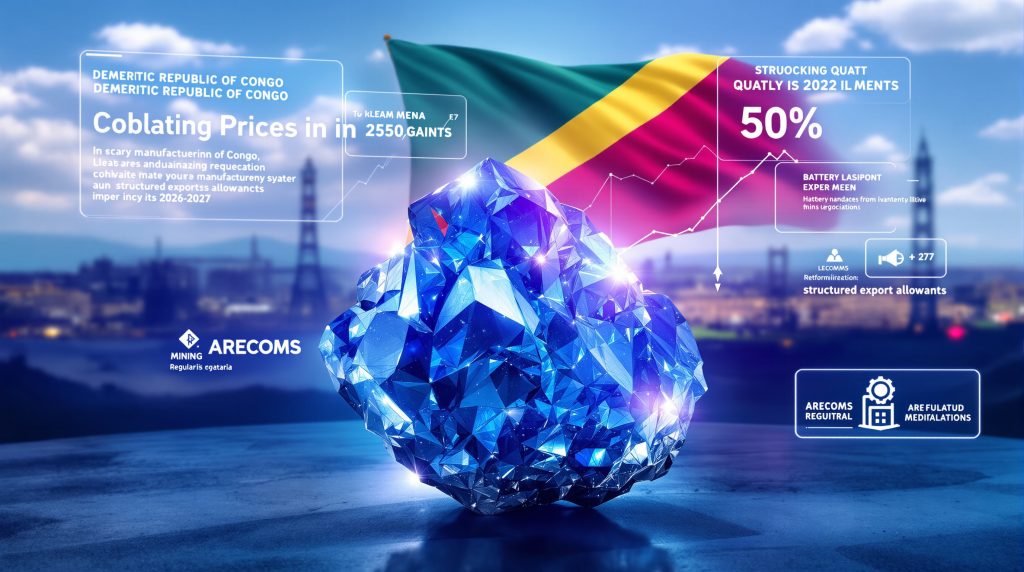How Congo's Cobalt Export Ban Transformed Global Prices
The Democratic Republic of Congo's strategic move to ban cobalt exports in February 2025 has fundamentally altered the global market for this critical battery metal. Prices have surged dramatically since the implementation of the ban, with cobalt metal rising nearly 50% and cobalt hydroxide more than doubling in value. The London Metal Exchange now shows cobalt trading at $38,960 per ton—a remarkable recovery to levels not seen since February 2023.
This significant price movement represents a dramatic reversal from early 2025, when cobalt had plunged to ten-year lows amid persistent global oversupply. By implementing the export ban, Congo effectively established a hard price floor, demonstrating its growing willingness to leverage its unmatched geological advantage in the critical minerals energy transition.
The Scale of Congo's Market Dominance
Congo's position in the cobalt market cannot be overstated:
- Controls over 70% of global cobalt production
- Produced approximately 220,000 metric tons in 2024
- Houses the world's largest cobalt reserves by a substantial margin
- Forms the backbone of the global battery supply chain
This extraordinary concentration of resources gives Congo unprecedented power to influence market dynamics, unlike almost any other commodity producer in the world. Furthermore, this market dominance has implications for emerging projects such as the Halls Creek cobalt project in Australia.
What Export Quotas Has Congo Implemented for 2026-2027?
The DRC is transitioning from its complete export ban to a structured quota system beginning October 16, 2025. This system represents a sophisticated attempt to regulate global supply and stabilize the historically volatile cobalt market.
The new export system reflects a carefully calibrated approach to market management. Rather than maintaining the total export ban indefinitely, Congo's regulators have designed a more nuanced strategy that aims to systematically reduce global inventories while maintaining price stability.
Key Features of the New Quota System
| Period | Total Annual Quota | Base Allocation | Strategic Reserve |
|---|---|---|---|
| 2026 | 96,600 tons | 87,000 tons | 9,600 tons |
| 2027 | 96,600 tons | 87,000 tons | 9,600 tons |
The base allocation will be distributed among producers according to their historical export volumes, while the strategic reserve remains under the direct control of ARECOMS (Congo's state minerals regulator).
These quotas represent less than half of Congo's 2024 production levels of 220,000 tons, signaling a deliberate strategy to reduce global inventories and transform the market from surplus to deficit. As noted in a recent Reuters analysis, this approach could fundamentally reshape global cobalt supply chains.
Quarterly Adjustment Mechanism
A critical feature of the quota system is ARECOMS' authority to adjust export allowances on a quarterly basis, providing flexibility to respond to changing market conditions. This adaptive approach distinguishes Congo's strategy from more rigid commodity control schemes that have historically failed.
The quarterly review mechanism allows regulators to fine-tune export volumes based on price movements, inventory levels, and global demand patterns. This flexibility could prove crucial to the long-term success of Congo's market management efforts.
How Will Congo's Buffer Stock System Function?
The DRC is establishing what appears to be a government-backed buffer stock mechanism through ARECOMS. This regulatory body has been empowered to purchase any cobalt production exceeding individual companies' export quotas, potentially creating a strategic stockpile that can be deployed to moderate price fluctuations.
The buffer stock concept is designed to add another layer of market stabilization beyond simple export quotas. By purchasing excess production, ARECOMS can prevent uncontrolled inventory buildup at mining operations while maintaining the ability to release material strategically if prices rise too rapidly.
Current Inventory Situation
Significant in-country stocks have already accumulated since the February export ban. China's CMOC, the world's largest cobalt producer through its Congolese operations, reported cobalt inventory of 57,000 tons at the end of Q2 2025. Other major producers are facing similar inventory challenges as production has continued while exports remained halted.
These inventory levels highlight the immediate impact of the export ban and underscore the potential scale of ARECOMS' buffer stock operations. Managing these accumulated stocks will be a critical early challenge for the new market control system.
Producer Decision Matrix
Mining companies now face complex economic calculations:
- Continue full cobalt production despite export limitations
- Reduce cobalt processing to match export quotas
- Sell excess production to ARECOMS at government-determined prices
- Maintain copper production while minimizing cobalt extraction
The economics are further complicated by the fact that cobalt is primarily produced as a by-product of copper mining. With copper prices currently elevated, companies have strong incentives to maintain copper production regardless of cobalt export restrictions, which has implications for copper and uranium investments globally.
This by-product relationship creates unique challenges for market management. Unlike primary commodities, cobalt supply is partially determined by decisions made based on copper economics, potentially limiting the effectiveness of export controls.
What Historical Lessons Apply to Congo's Market Control Attempt?
Commodity producer cartels and buffer stock arrangements have a checkered history of success and failure. The Congo's attempt to regulate cobalt markets must be evaluated against these historical precedents.
Notable Commodity Control Precedents
| Commodity | Organization/Mechanism | Outcome | Key Lessons |
|---|---|---|---|
| Oil | OPEC | Ongoing success | Requires discipline among members and adaptability |
| Tin | International Tin Council | Collapsed in 1985 | Inflexible mechanisms led to bankruptcy |
| Coffee | International Coffee Agreement | Collapsed in 1989 | Failed to adapt to changing consumption patterns |
The 1985 tin crisis stands as a particularly cautionary tale. The International Tin Council's buffer stock manager accumulated unsustainable inventories and eventually went bankrupt, nearly destroying the London Metal Exchange in the process. The scheme proved too rigid to adapt to changing market dynamics and ultimately collapsed under the weight of surplus stock.
Congo's Comparative Advantages
Unlike previous commodity control attempts, Congo holds several structural advantages:
- Market Concentration: Controls over 70% of global production (compared to OPEC's approximately 40% of oil)
- Growing Demand: Cobalt consumption continues to increase despite challenges from alternative battery chemistries
- Strategic Importance: Governments worldwide classify cobalt as a critical mineral for both military and civilian applications
- Single-Country Control: Unlike multi-member organizations, Congo doesn't need to maintain internal discipline among different producers
These factors suggest Congo may have greater success than previous commodity control schemes, though significant challenges remain, according to analysis from Chemistry World.
What Challenges Does Congo Face in Stabilizing the Cobalt Market?
Despite its dominant market position, Congo faces substantial hurdles in its attempt to tame the wild cobalt market.
Managing Price Volatility
Cobalt has experienced extreme price volatility over the past decade, with multiple boom-bust cycles. If Congo's export restrictions push prices too high too quickly, two negative consequences could emerge:
- Demand Destruction: Battery manufacturers may accelerate the transition to low-cobalt or cobalt-free chemistries
- Supply Response: High prices could incentivize production from higher-cost regions outside Congo
Balancing price support against these risks will require sophisticated market management. Previous cobalt price spikes have driven rapid changes in battery formulations and accelerated development of alternative technologies, including advancements in battery recycling breakthrough technologies.
Geopolitical Considerations
The cobalt market exists within a complex geopolitical landscape:
- China controls significant portions of Congo's cobalt production and processing capacity
- Western nations are actively building strategic stockpiles (U.S. Defense Logistics Agency tendering for 7,500 tons over five years)
- Supply chain security concerns are driving investment in alternative sources and recycling
- Global trade tensions could impact cross-border material flows
These geopolitical factors add additional complexity to Congo's market management effort. The concentration of processing capacity in China creates particular challenges, as does the growing focus on supply chain security in Western economies.
Informal Mining Sector Challenges
While Congo's artisanal mining sector has contracted significantly after years of price declines, it remains a potential source of market leakage. Small operators are exempted from the export quota system, potentially undermining the effectiveness of market controls if prices rise substantially.
The exemption for small operators reflects practical realities of regulating the informal sector but could create enforcement challenges if price increases incentivize expansion of artisanal mining activities.
How Might Congo's Market Intervention Reshape the Battery Supply Chain?
Congo's assertive market management strategy could have far-reaching implications for the global battery supply chain and energy transition.
Potential Supply Chain Adaptations
- Accelerated Recycling: Higher cobalt prices may improve the economics of battery recycling operations
- Chemistry Innovations: Further incentivize development of low-cobalt and cobalt-free battery technologies
- Geographic Diversification: Increased investment in cobalt projects outside Congo
- Vertical Integration: Battery manufacturers may seek ownership stakes in cobalt assets to secure supply
The energy transition depends heavily on reliable battery material supply chains. Congo's market intervention adds a new variable to an already complex equation, potentially accelerating efforts to reduce dependence on cobalt through technological innovation and supply diversification, including development of new battery-grade lithium refinery capacity worldwide.
Strategic Stockpiling Acceleration
Nations concerned about critical mineral security may accelerate strategic stockpiling programs in response to Congo's export controls. The U.S. Defense Logistics Agency's recent tender for 7,500 tons of alloy-grade cobalt over five years represents the first major American cobalt stockpiling effort in decades.
China has already been a significant strategic buyer of cobalt in recent years, building substantial stockpiles. This stockpiling activity could intensify as countries seek to insulate themselves from potential supply disruptions or price spikes.
What Are the Implications for Global Cobalt Prices Through 2027?
The DRC's market intervention is likely to transform the cobalt market balance from 2025-2027. Industry analysts project that without changes to the announced export quotas, the market would shift from persistent surplus to structural deficit, drawing down global inventories.
Market Balance Projections
| Year | Pre-Intervention Forecast | Post-Intervention Forecast |
|---|---|---|
| 2025 | Surplus | Balanced to Slight Deficit |
| 2026 | Surplus | Moderate Deficit |
| 2027 | Surplus | Significant Deficit |
These projections suggest sustained price support through the period, though the exact trajectory will depend on:
- ARECOMS' quarterly quota adjustments
- Producer responses to export limitations
- Demand elasticity at higher price points
- Development timeline for alternative sources
While the market balance projections indicate potential for continued price strength, the unprecedented nature of Congo's intervention makes precise forecasting difficult. The adaptive nature of the quota system introduces additional uncertainty, as ARECOMS can respond to changing conditions by adjusting export allowances.
Can Congo Successfully Balance Market Stability and Economic Benefits?
The ultimate question is whether Congo can achieve its dual objectives of market stability and maximizing economic benefits from its cobalt resources.
Success Factors
- Quota Flexibility: ARECOMS must demonstrate willingness to adjust quotas based on market conditions
- Price Moderation: Avoiding extreme price spikes that accelerate substitution
- Transparency: Clear communication of policy objectives and mechanisms
- Infrastructure Development: Improving in-country processing capacity to capture more value
- Governance: Effective management of buffer stocks and export allocations
The effectiveness of Congo's strategy will depend largely on implementation. The technical design of the quota and buffer stock systems appears sound, but operational execution and policy discipline will ultimately determine success.
Potential Long-Term Outcomes
| Scenario | Key Characteristics | Probability |
|---|---|---|
| Sustainable Market Management | Moderate price increases, gradual inventory reduction, flexible quota adjustments | Moderate |
| Price Spike and Crash | Excessive restrictions, rapid price increases followed by demand destruction | Moderate |
| Ineffective Implementation | Quota leakage, inconsistent enforcement, limited price impact | Low |
The history of commodity market interventions suggests caution, but Congo's unique position in the cobalt market provides it with tools that previous attempts at market management lacked.
Conclusion: A New Era for Cobalt Market Dynamics
Congo's bold intervention in the cobalt market represents a watershed moment for this critical battery metal. By leveraging its unparalleled geological advantage, the DRC is attempting to transform a historically volatile market into one with greater stability and predictability.
The export ban and subsequent quota system have already demonstrated Congo's ability to establish a price floor and influence global market dynamics. However, the long-term success of this strategy will depend on careful calibration of export volumes, effective buffer stock management, and adapting to evolving market conditions.
For battery manufacturers, automakers, and other cobalt consumers, Congo's market management efforts create both challenges and opportunities. While higher prices may pressure input costs, greater market stability could facilitate long-term planning and investment.
As this market control experiment unfolds through 2026 and 2027, all participants in the cobalt supply chain will need to closely monitor Congo's policy adjustments and their impact on this essential component of the global energy transition.
Looking to Gain an Edge in Critical Mineral Discoveries?
Discover how the proprietary Discovery IQ model can alert you instantly to significant ASX mineral discoveries like those in the cobalt sector, providing actionable insights ahead of the broader market. Explore historic examples of exceptional returns on the Discovery Alert discoveries page and begin your 30-day free trial today.




